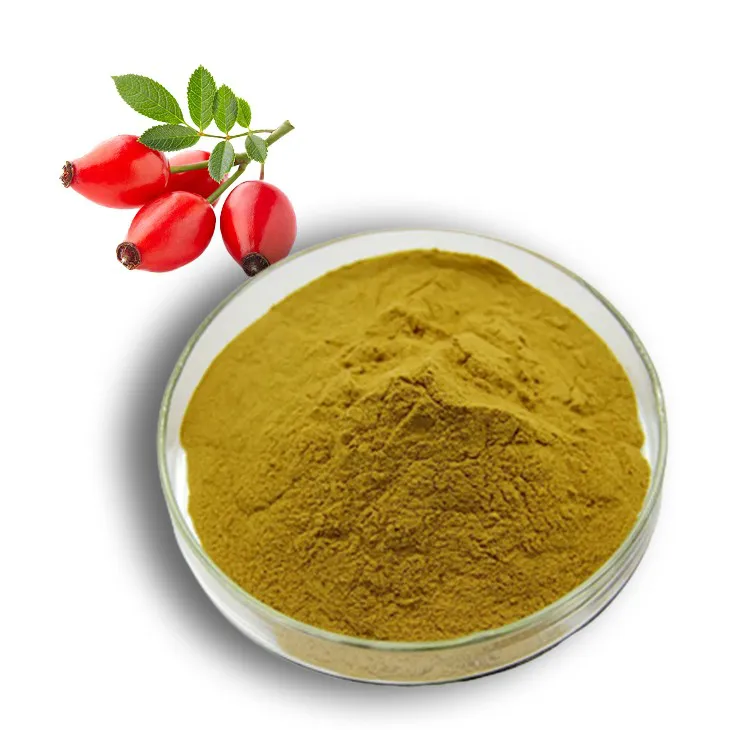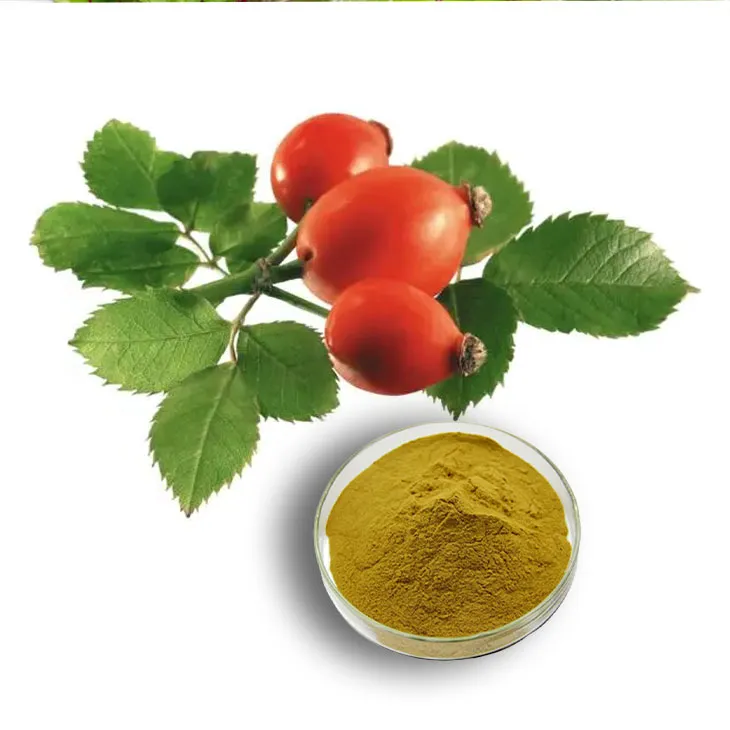- 0086-571-85302990
- sales@greenskybio.com
The process of extracting lycopene from rose hip in rose hip extract.
2024-11-29

1. Introduction
Rose hips are well - known for their rich nutritional content, and among the valuable components, Lycopene stands out. Lycopene is a powerful antioxidant with numerous health benefits. The extraction of Lycopene from Rose Hip Extract is an important process that has attracted significant attention in the fields of food, pharmaceuticals, and cosmetics. This article will delve into the detailed process of extracting lycopene from Rose Hip Extract.

2. Rose Hip Processing for Extract Preparation
2.1 Harvesting of Rose Hips
The first step in obtaining Rose Hip Extract is the proper harvesting of rose hips. Rose hips should be harvested at the right stage of maturity. If they are harvested too early, they may not have developed the full complement of nutrients, including lycopene. On the other hand, if they are harvested too late, there may be a risk of spoilage or degradation of some components. Generally, rose hips are harvested when they are fully ripe, which is often indicated by a bright red or orange color.2.2 Cleaning and Preparation
Once harvested, the rose hips need to be thoroughly cleaned. This involves removing any dirt, debris, leaves, or stems that may be attached to them. After cleaning, they may be dried or processed immediately depending on the extraction method to be used. Drying can be done under controlled conditions to preserve the integrity of the components. Some drying methods include air - drying, oven - drying at low temperatures, or freeze - drying.2.3 Initial Extraction for Rose Hip Extract
To obtain the rose hip extract, a suitable extraction method is employed. One common method is solvent extraction. A solvent such as ethanol or water can be used. For example, in the case of ethanol extraction, the rose hips are soaked in ethanol for a certain period of time. This allows the soluble components, including some precursors to lycopene and other bioactive compounds, to dissolve in the ethanol. The mixture is then filtered to separate the liquid extract from the solid residue. Another method could be supercritical fluid extraction, which uses supercritical carbon dioxide. This method has the advantage of being more environmentally friendly and can produce a high - quality extract with a relatively pure profile of components.
3. Selection of Solvent System for Lycopene Extraction
3.1 Consideration of Organic Solvents
When it comes to extracting lycopene from the rose hip extract, the selection of a solvent system is crucial. Organic solvents like hexane or ethyl acetate are often considered. Hexane is a non - polar solvent that has a good affinity for lycopene, which is also relatively non - polar. It can effectively dissolve lycopene from the rose hip extract. However, hexane has some disadvantages, such as its flammability and potential toxicity. Ethyl acetate, on the other hand, is a less toxic alternative. It has a certain polarity that can also extract lycopene while being more acceptable in terms of safety for some applications.3.2 Solvent Mixtures
In some cases, solvent mixtures may be used. For example, a combination of hexane and ethyl acetate can be formulated to optimize the extraction of lycopene. The ratio of the two solvents in the mixture can be adjusted according to the characteristics of the rose hip extract and the desired extraction efficiency. By using a solvent mixture, it is possible to take advantage of the properties of both solvents, such as the high solubility power of hexane and the relatively better safety profile of ethyl acetate.3.3 Solvent - Extract Interaction
The interaction between the solvent and the rose hip extract is complex. The solvent not only needs to dissolve lycopene but also should not cause significant degradation or alteration of other components in the extract. The solubility of lycopene in the solvent is affected by factors such as temperature and the presence of other substances in the extract. For example, if there are other lipids or compounds with similar solubility characteristics in the rose hip extract, they may compete with lycopene for solvent binding sites, which can affect the overall extraction efficiency.
4. Optimization of the Extraction Process
4.1 Temperature Control
Temperature plays a vital role in the extraction of lycopene from rose hip extract. Generally, an appropriate increase in temperature can enhance the solubility of lycopene in the solvent, thus increasing the extraction efficiency. However, if the temperature is too high, it may lead to the degradation of lycopene or other components in the rose hip extract. For example, lycopene is sensitive to heat, and at high temperatures, it may undergo isomerization or oxidation reactions. Therefore, a carefully controlled temperature range is required. In most cases, a temperature between 30 - 50°C may be suitable for extraction using organic solvents like hexane or ethyl acetate.4.2 Pressure Control
In some extraction methods, such as supercritical fluid extraction, pressure is an important factor. For the extraction of lycopene from rose hip extract using supercritical carbon dioxide, the pressure needs to be adjusted to maintain the supercritical state of the carbon dioxide. The appropriate pressure can affect the density and solubility of the supercritical fluid, which in turn influences the extraction efficiency. Higher pressures can generally increase the solubility of lycopene in the supercritical fluid, but too high a pressure may also lead to equipment requirements and safety issues.4.3 Time Consideration
The extraction time also needs to be optimized. If the extraction time is too short, the lycopene may not be fully extracted from the rose hip extract. However, if the extraction time is too long, it may not only lead to a waste of resources but also increase the risk of degradation of lycopene and other components. The optimal extraction time depends on various factors such as the solvent used, the temperature, and the nature of the rose hip extract. In general, extraction times ranging from 1 - 3 hours may be considered for solvent - based extractions.5. Separation and Purification of Lycopene
5.1 Chromatography Techniques
After the extraction of lycopene from the rose hip extract, separation and purification procedures are necessary to obtain pure lycopene. Chromatography techniques are commonly used for this purpose. Column chromatography is one such technique. In column chromatography, a column is filled with a stationary phase, such as silica gel or alumina. The extract containing lycopene is loaded onto the top of the column, and a mobile phase, which can be a solvent or a solvent mixture, is passed through the column. Due to the different affinities of lycopene and other components in the extract for the stationary and mobile phases, they are separated as they move through the column. Lycopene can be collected at the appropriate fraction.5.2 High - Performance Liquid Chromatography (HPLC)
High - Performance Liquid Chromatography (HPLC) is another powerful technique for the separation and purification of lycopene. HPLC offers high resolution and can accurately separate lycopene from other closely related compounds. It uses a high - pressure pump to deliver the mobile phase through a column packed with a very fine stationary phase. The detector in HPLC can detect the eluted lycopene, and the purity of the lycopene can be determined. HPLC is often used for the final purification of lycopene to obtain a high - quality product with a high degree of purity.5.3 Crystallization
Crystallization can also be used as a purification method for lycopene obtained from rose hip extract. By carefully controlling the conditions such as temperature, solvent evaporation rate, and the addition of anti - solvents, lycopene can be made to crystallize out of the solution. The crystals can then be separated from the remaining liquid, which contains impurities. This method can be used in combination with chromatography techniques to further purify lycopene.6. Properties and Applications of Lycopene from Rose Hip Extract
6.1 Properties
Lycopene obtained from rose hip extract has several notable properties. It is a red - colored pigment, which gives it applications in the coloring of food and cosmetics. It is also a powerful antioxidant, capable of scavenging free radicals in the body. Lycopene has a relatively long - chain conjugated double - bond structure, which contributes to its antioxidant activity. In addition, it has a certain degree of solubility in lipids, which affects its bioavailability and distribution in the body.6.2 Applications in Food
In the food industry, lycopene from rose hip extract can be used as a natural food colorant. It can be added to products such as juices, jams, and processed meats to give them a natural red color. Moreover, due to its antioxidant properties, it can also be used to extend the shelf - life of food products by preventing oxidative spoilage. For example, in tomato - based products, the addition of lycopene from rose hip extract can enhance the antioxidant content and improve the overall quality of the product.6.3 Applications in Pharmaceuticals and Cosmetics
In the pharmaceutical field, lycopene has potential health - promoting effects. It has been studied for its role in preventing certain types of cancers, such as prostate cancer. In cosmetics, lycopene can be used in skin - care products. Its antioxidant properties can help protect the skin from damage caused by free radicals, such as UV - induced oxidative stress. It can be incorporated into creams, lotions, and serums to improve skin health and appearance.7. Conclusion
The extraction of lycopene from rose hip extract is a complex but important process. From the initial processing of rose hips to the final purification of lycopene, each step requires careful consideration and control. The selection of the solvent system, optimization of the extraction process, and separation and purification techniques all play crucial roles in obtaining high - quality lycopene. The lycopene obtained from rose hip extract has diverse properties and applications in various industries, making it a valuable compound worthy of further research and development.
FAQ:
What are the main factors to consider when selecting a solvent system for lycopene extraction from rosehip extract?
The main factors include the solubility of lycopene in the solvent, the selectivity of the solvent towards lycopene compared to other components in the rosehip extract, the toxicity of the solvent, and its cost - effectiveness. For example, hexane and ethyl acetate are considered because they can dissolve lycopene well, but their toxicity also needs to be managed during the extraction process.
How is the temperature controlled during the extraction of lycopene from rosehip extract?
Temperature control is crucial for optimizing the yield of lycopene extraction. It is usually achieved by using specialized equipment such as thermostatically controlled water baths or heating mantles. The appropriate temperature range is determined through pre - experiments. If the temperature is too low, the extraction rate may be slow; if it is too high, it may cause degradation of lycopene or unwanted reactions with other components in the extract.
What are the common chromatography techniques used for the separation and purification of lycopene from rosehip extract?
High - performance liquid chromatography (HPLC) is a very common technique. It can separate lycopene from other components based on differences in their interaction with the stationary and mobile phases. Column chromatography is also used sometimes. In column chromatography, a solid adsorbent is used in a column, and the sample is passed through it, with different components being retained to different extents depending on their chemical properties.
What are the unique properties of lycopene obtained from rosehip extract?
Lycopene obtained from rosehip extract has antioxidant properties, which can help in scavenging free radicals in the body. It also has a characteristic red color, which can be used for coloring in the food and cosmetic industries. Additionally, it may have some potential health benefits such as reducing the risk of certain diseases, although more research is needed to fully understand these effects.
What are the applications of lycopene from rosehip extract in the food industry?
It can be used as a natural food coloring agent, adding a red hue to products. It can also be added to functional foods as an antioxidant ingredient. For example, it may be incorporated into juices, jams, and processed meat products. Lycopene can potentially improve the shelf - life of these products by preventing oxidation.
Related literature
- Extraction and Characterization of Lycopene from Rosehip: A Comprehensive Review"
- "Optimizing the Lycopene Extraction Process from Rosehip Extract: New Insights"
- "Lycopene in Rosehip: Properties, Extraction, and Applications in the Food and Cosmetic Industries"
- ▶ Hesperidin
- ▶ Citrus Bioflavonoids
- ▶ Plant Extract
- ▶ lycopene
- ▶ Diosmin
- ▶ Grape seed extract
- ▶ Sea buckthorn Juice Powder
- ▶ Fruit Juice Powder
- ▶ Hops Extract
- ▶ Artichoke Extract
- ▶ Mushroom extract
- ▶ Astaxanthin
- ▶ Green Tea Extract
- ▶ Curcumin
- ▶ Horse Chestnut Extract
- ▶ Other Product
- ▶ Boswellia Serrata Extract
- ▶ Resveratrol
- ▶ Marigold Extract
- ▶ Grape Leaf Extract
- ▶ New Product
- ▶ Aminolevulinic acid
- ▶ Cranberry Extract
- ▶ Red Yeast Rice
- ▶ Red Wine Extract
-
Curcuma Longa Extract/Turmeric extract
2024-11-29
-
Coix Seed Extract
2024-11-29
-
Dandelion Leaf Extract
2024-11-29
-
Artichoke Extract
2024-11-29
-
Shikone Extract
2024-11-29
-
Selenium yeast
2024-11-29
-
Polygonum multiflorum extract
2024-11-29
-
Cat Claw Extract
2024-11-29
-
Chasteberry Extract
2024-11-29
-
Curcuma Longa Extract
2024-11-29





















